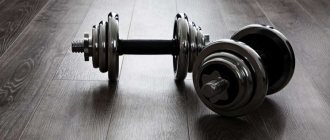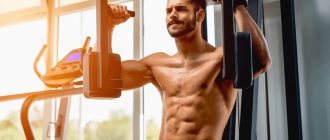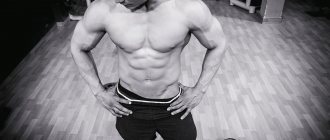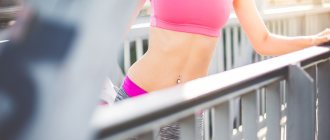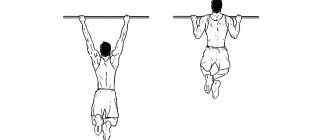More and more teenagers - boys and girls - as they age, want to start doing fitness at home or in the gym to build up their muscle mass. This goal is mainly pursued by boys. Girls want to tighten up their figure, just take the first step towards its transformation and start working out at home to improve their health, achieving a beautiful physique.
A sports lifestyle from school is a direct path to good health, a beautiful physique and longevity. But an incorrectly selected training program at this age can lead to serious injuries if the set of exercises is incorrectly designed in terms of loads, repetitions and nutrition.
Today you will find out what exercises are recommended for fitness at home and in the gym for ages 11-17, plus examples of monthly training programs for boys and girls, if you exercise two to three times a week for a month.
Age for fitness training at home and in the gym
Everyone who starts playing sports has different ages. Some people start training from an early age. Basically, all teenagers begin to engage actively, pursuing a specific goal, at the age of 11-17 years, joining sports (fitness, exercises with barbells, dumbbells and other fitness equipment that transforms the figure). It can also be a home universal fitness machine of a block format, where you can perform many exercises at once for different muscle groups (for example, back, legs, triceps, biceps, abs). The main thing is to know the correct approach to such simulators, and then you can replace dumbbells and barbells with a universal simulator.
But it is not always possible to do everything on it, since there are different exercises that involve one muscle group (basic), while others involve more than two or three muscle groups (isolated). Basically, up to 30 exercises can be performed on universal simulators, depending on the design of the simulator and its block levers.
How to interest a boy or girl aged 11-19 years in sports
- Personal example. A dad or mom who plays sports is the best motivator for a teenager. Children of such parents will be active from birth, and sports will be a way of life for them.
- Child's preferences. Ask your teenager what sport he would like to do and what he likes most. Surely there will be something that interests him. Remember that any teenager can play sports.
- Don't push. Don’t force your grown-up son or daughter to go and sign up for a sports section. Better use the “back door” technique. While watching a TV show, reading a magazine, or browsing beauty and health websites, make subtle comments such as “It would be interesting to see you in this situation,” etc. Teens will understand your desire, but they will have freedom of choice.
- Fight bad habits in a civilized manner. Don't be too shocked by your first cigarette or cocktail. Better show enlarged photos of the consequences of smoking and alcoholism.
- Let him choose for himself. Has your daughter signed up for boxing? Let him try. In any case, he will gain useful experience and learn something from the coach.
"Advice. If you properly interest a teenager in sports, he will soon ask permission to enroll in one or another section or ask to buy a skateboard.”
For children 11-14 years old
To get a child aged 11-14 years interested in sports, use a motivation method that is understandable to him. For example, you can say to a girl: “Do you want to become like your favorite heroine?” (Disney princess, Winx doll or favorite singer). To the boy: “Do you want to become strong like a superhero?”
For 15-19 year olds
We suggest talking with teenagers 15-19 years old as follows. With girls: “Did you want to become slimmer, more flexible and attractive? I can tell you how to achieve this." With young men: “I know how to be cool.” Another method that has an effect is when parents talk about famous personalities and what sports they play. For example: “Did you know that Haruki Murakami is a keen runner and participates in marathons?”
Video motivator for a teenager to start playing sports
The main thing in getting used to sports is to prove that you need to strive not for records, but for physical development and maintaining good physical shape. Explain to your teenager that playing sports is the key to a happy, healthy, successful and long life.
Training with barbells and dumbbells for boys and girls aged 11-17 years
Why do all teenagers buy dumbbells and barbells for home workouts?
The answer is simple: you can perform much more exercises with dumbbells and a barbell (up to 100 exercises, having in your arsenal a collapsible barbell up to 50 kg and a barbell rack). In order not to disturb your neighbors and avoid noise, you should also purchase rubberized mats, which soften the impact when weights and weights fall. You also need prefabricated dumbbells up to 40 kg and a bench so that you can perform a number of exercises in sitting positions with dumbbells or lying down with a barbell. Don't forget about safety precautions.
To avoid being crushed by the barbell, it is always better to use a lighter weight with which you can confidently perform an approach with a certain number of repetitions (up to 10 - 15 times).
How to increase the load?
In order for a teenager to make progress in pumping his legs, he must periodically increase his load. This should be done when the teenager notices that the exercises have become easy to perform. And they no longer cause the same feeling of fatigue as before.
To increase the load, a teenager needs:
- Stop resting for long periods between sets and reps.
- Start doing the exercises more slowly. So that the body is under load for as long as possible.
- Do sets of exercises periodically. Perform sets with minimal rest. Or without it at all.
- Do more reps. Use means for additional load (dumbbells).
All of these recommendations will help your teenager increase their load effectively and safely.
Mistakes in the gym and at home when performing the Bench Press exercise
Typically, unsuccessful approaches occur when the weight on the bar exceeds your maximum possible. Then the “dancing” begins with the barbell, which you want to throw off yourself as quickly as possible. There is a danger when performing any exercise, but the bench press always requires a partner, since you are working with heavy weights. The muscles work at maximum capacity, and when they fail, there will be no strength. The barbell may fall onto your chest when bench pressing.
Your partner will always help you raise it . And if it is not there, then there is always one way - either roll it along the body down to the legs, or drop the barbell to one side to remove the load from the chest. The worst thing is when the barbell ends up on your throat. Then you need to move the barbell to the side and try to get out in the opposite direction from the one where you removed the weight of the barbell. Then you need to lift one side of the bar with the least weight to get out. And this will be a lesson to you that the bench press should always be performed with a partner who will help you!
Negative effects of strength training
During adolescence, the body develops and grows. The musculoskeletal system is not yet formed. Some of its parts, for example, intervertebral discs, are excessively flexible, and the muscles that support the spine are not sufficiently formed, so performing exercises that have an axial load are strictly contraindicated.
But not only because of this, iron sports are contraindicated for a teenager. At this early age, the cardiovascular system also undergoes changes and develops. The stress on the cardiovascular system during weight training at this age has a detrimental effect on the body. Strength training in adolescence can be done, but the training process is somewhat different from the strength training we are used to.
So, here is a list of negative effects on a teenager’s body when performing strength training without taking into account the characteristics of the body:
- Disorders in the cardiovascular system.
- Slowing bone growth and possible deformation.
- Poor posture.
- Serious injuries to joints and spine are possible.
It's always easier to do exercises at home with dumbbells
If you can't perform a set of dumbbells on the bench press, you can always move them to the sides. There is no need to throw them on your chest or head if you were unable to lift them. This can lead to injury, because if the muscles fail, dumbbells weighing 10, 20, 30 kg can harm you if you drop them on your body where there are no muscles. Only professional athletes sometimes put dumbbells on themselves to complete the last reps. But they already know from experience their strength and endurance potential after years of training with iron, regardless of where they train their muscles - at home or in the gym.
A sports lifestyle from school is a direct path to good health, a beautiful physique and longevity. But an incorrectly selected training program at this age can lead to serious injuries.
How to gain muscle mass as a teenager
Training program for a month (two to three times a week). Before starting the workout, you should do a joint warm-up for 10 minutes, and also jump rope for 5-10 minutes without a break to prepare the body for the load.
The training program is designed to work all major muscle groups (chest, abs, legs, biceps, triceps, back) taking into account an understanding of how to correctly perform exercises from a technical point of view.
How to calculate the load correctly?
In each approach where there is a certain number of repetitions, you should leave a reserve of no more than 3 repetitions. If the margin is greater, then it is necessary to increase the load to a margin of three repetitions. If these are squats, then you need to pick up dumbbells and perform the exercise.
Training Basics for Teens
When doing fitness, teenagers' muscles, ligaments, tendons and bones are strengthened, which significantly reduces the risk of injury. Although a 16-year-old teenager will not experience the same benefits from exercise as an adult, playing sports will bring many benefits to their health and prepare their body for serious training.
For children under 12-15 years of age, exercises in which the spine works to “compress” and “twist” should not be performed. Young people from 16-17 years old can gradually introduce into the training program such exercises as: deadlift, squats with a barbell, leg press, military press. If you start using them earlier, there is a risk of inhibiting the natural growth of the body and causing serious injuries to the spine.
Example of a training program (set of exercises) for boys
1 and 3 weeks
Monday – chest, back, shoulders, biceps, triceps, abs day
- Push-ups 10-20 reps 3 sets
- Bent-over barbell rows 8-10 reps 3 sets
- Standing Dumbbell Press 8-10 reps 3 sets
- Standing biceps curls with dumbbells 8-10 times 3 sets
- Triceps Bent Over Arm Extension 8 reps 3 sets
- Dorsal Curl 10-20 reps 3 sets
- Stretching all muscle groups after training – 10 min.
Wednesday – day of legs, quadriceps, biceps, thighs, buttocks, abs and back
- Classic squats 2-3 sets 20-30 reps
- Lunges in place with dumbbells 3 sets 8-10 times
- Deadlift with dumbbells 3 sets 10 reps
- Plank press 3 sets 30-60 seconds
- Stretching all muscle groups after training – 10 min (leg muscles)
Friday – chest, back, shoulders, biceps, triceps, abs day
- Push-ups 10-20 reps 3 sets
- Bent-over barbell rows 8-10 reps 3 sets
- Standing Dumbbell Press 8-10 reps 3 sets
- Standing biceps curls with dumbbells 8-10 times 3 sets
- Triceps Bent Over Arm Extension 8 reps 3 sets
- Dorsal Curl 10-20 reps 3 sets
- Stretching all muscle groups after training – 10 min (torso muscles)
2 and 4 weeks
Monday – chest, back, shoulders, biceps, triceps, abs day
- Dumbbell bench press 8-10 reps 3 sets
- Bent-over barbell rows 6-8 reps 3 sets
- Standing dumbbell raises to the side 8-10 reps 3 sets
- Standing biceps curls 8-10 times 3 sets
- Overhead arm extension 8 reps 3 sets
- Dorsal Curl 10-20 reps 3 sets
- Stretching all muscle groups after training – 10 min.
Wednesday – day of legs, quadriceps, biceps, thighs, buttocks, abs and back
- Classic squats 2-3 sets with dumbbells 8-10 reps
- Lunges with leg lifts with dumbbells 3 sets 8-10 times
- Barbell deadlift 3 sets 10 reps
- Plank press 3 sets 30 – 60 seconds
- Stretching all muscle groups after training – 10 min (leg muscles)
Friday – chest, back, shoulders, biceps, triceps, abs day
- Push-ups 10-20 reps 3 sets
- Bent-over barbell rows 8-10 reps 3 sets
- Standing Dumbbell Press 8-10 reps 3 sets
- Standing biceps curls with dumbbells 8-10 times 3 sets
- Triceps Bent Over Arm Extension 8 reps 3 sets
- Dorsal Curl 10-20 reps 3 sets
- Stretching all muscle groups after training – 10 min (torso muscles)
3 week
Tuesday – chest, back, shoulders, biceps, triceps, abs day
- Bench press 8-10 reps 3 sets
- Bent-over barbell rows 6-8 reps 3 sets
- Dumbbell bench press up 8-10 reps 3 sets
- Standing biceps curls 8-10 times 3 sets
- Overhead arm extension 8 reps 3 sets
- Dorsal Curl 15-20 reps 3 sets
- Stretching all muscle groups after training – 10 min.
Friday – chest, back, shoulders, biceps, triceps, abs day
- Push-ups 10-20 reps 3 sets
- Bent-over barbell rows 8-10 reps 3 sets
- Standing Dumbbell Press 8-10 reps 3 sets
- Standing biceps curls with dumbbells 8-10 times 3 sets
- Triceps Bent Over Arm Extension 8 reps 3 sets
- Dorsal Curl 10 -20 reps 3 sets
- Stretching all muscle groups after training – 10 min (torso muscles)
Training program for girls at home and in the gym
If boys want to develop all muscle groups and pump up their muscle mass, then girls want to pump up their legs, abs, and back, since they don’t need strong arms and broad shoulders. This training program is just for those who want to pump up their legs, buttocks, abs, and back.
Training program for a month (two to three times a week). Before starting the workout, you should do a joint warm-up for 10 minutes, and also jump rope for 5-10 minutes (without a break) to prepare the body for the load.
After a month of training, you will notice that your muscles have become more resilient and stronger. You shouldn’t do a lot of exercises at once; it’s a beginner’s mistake to do a lot of exercises on the same muscle group at once. To pump them up, you need a measure of load. Then the result will undoubtedly be, you just have to start training.
1 / 2 / 3 / 4 week
Monday – day of legs, buttocks, abs, back
- Kneeling push-ups on a mat 8-15 reps 3 sets
- Classic squats 10-20 reps 3 sets
- Lunges with dumbbells in place 8-10 reps 3 sets
- Standing deadlift with dumbbells 8-10 times 3 sets
- Plank 3 sets 30-50 seconds
- Dorsal Curl 15-20 reps 3 sets
- Stretching all muscle groups after training – 10 min.
Thursday – day of legs, buttocks, abs, back
- Lunges in place with dumbbells 3 sets 8-10 times
- Leg abduction to the side on the buttock (leg straight) 3 sets 20-30 times
- Deadlift with dumbbells 3 sets 10 reps
- Plank press 3 sets 30-60 seconds
- Dorsal Curl 15-20 reps 3 sets
- Stretching all muscle groups after training – 10 min (leg muscles)
